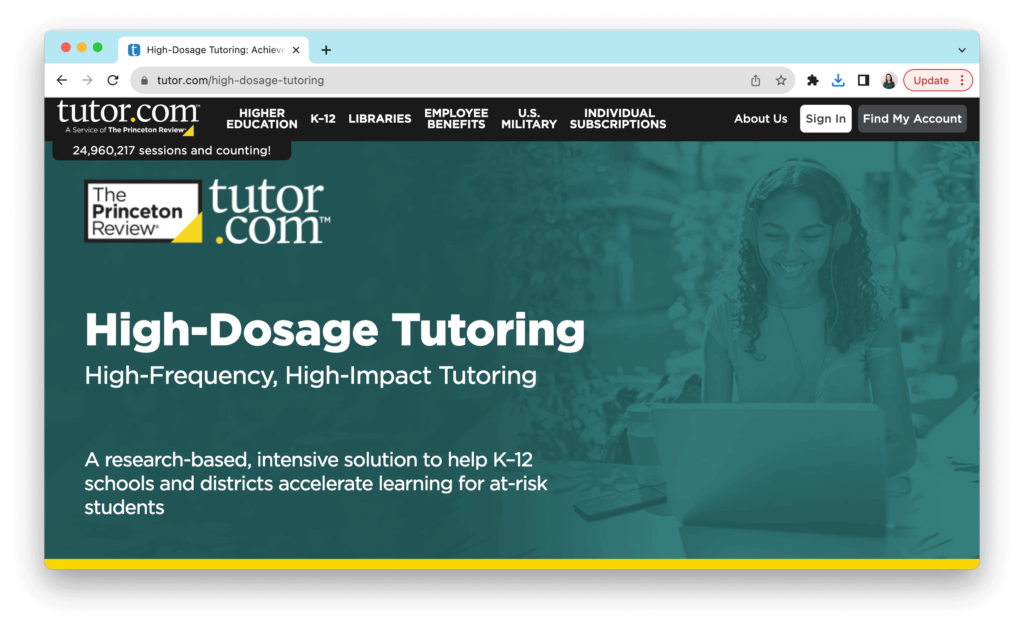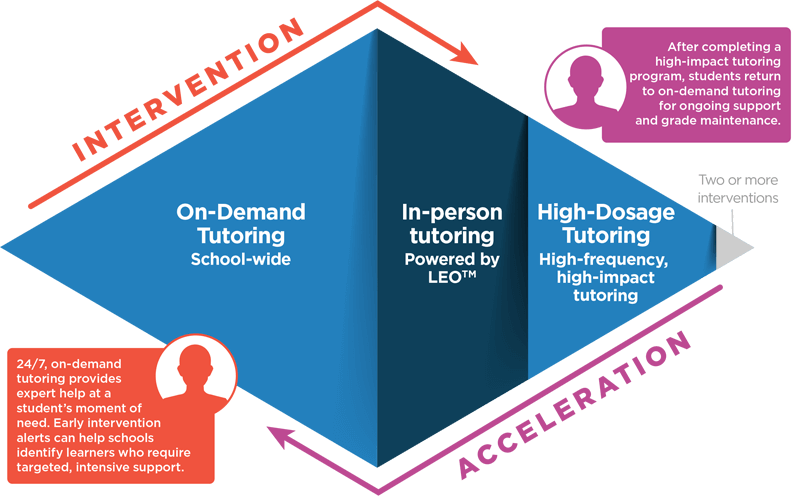Are you looking for a way to close achievement gaps and support all of the students in your school and district? High-dosage tutoring might be the solution you’re looking for! It’s a special kind of small group tutoring, backed by research, that could be the perfect fit for your students.
In today’s blog post, we’ll unpack the term high-dosage tutoring and look at a research-based solution from The Princeton Review and Tutor.com. It’s designed to help K–12 schools and districts accelerate learning for students who need additional support this school year.
What is High-Dosage Tutoring?
High-dosage tutoring has certain features that set it apart from traditional tutoring. Here’s a breakdown of some of the key features of a high-dosage tutoring model:
- 3+ times per week frequency: Instead of meeting just once a week or a few times a month, high-dosage tutoring takes place with much greater frequency. Students meet with a tutor at least three times a week to work intensively on making significant learning gains.
- Small-group instruction: Another key feature of high-dosage tutoring is the use of small groups. In this model, a tutor works with up to four students at a time. Each student has a Personalized Learning Plan.
- Assessment-based: High-dosage tutoring is rooted in regular assessments with timely and specific feedback. Tutors check for understanding and provide feedback to students based on formative and summative assessments.
- Aligned to state standards: In a high-dosage tutoring model, tailored instruction is aligned to state standards. Students work on content that reinforces school and district learning goals.
- Curriculum-driven: High-dosage tutoring is curriculum-driven and uses high-quality materials. With the model offered by Tutor.com, you can use their instructional curricula or your school or district’s materials.
- Consistent, relational learning: With high-dosage tutoring, the cadence and small-group nature of the engagements foster a consistent, relational learning environment for students. Students work with a frequency that helps them form beneficial relationships with their peers and tutors.

High-Dosage Tutoring in Action
If you’re new to the concept of high-dosage tutoring, there are a few videos that can help you see it in action. Teachers group students together, and a schedule is set. Students log in to a session; there are options for video as well as audio, along with chat. The tutor uses the “I Do – We Do – You Do” instructional approach, modeling new concepts for students, who can ask questions and then dive into their own supported practice.
In this dedicated virtual space, students and instructors can draw and use other tools in the proprietary online classroom. Tutors can move through slides and annotate their screens, engaging students with resources built into the platform. As students work through problems, their tutors can monitor progress in real time and offer support as needed.
High Demand for Tutoring
Tutor.com recently released a white paper outlining K–12 algebra tutoring trends. The report includes insights into recent student support needs, including:
- Significant demand for algebra tutoring, which correlates with historically low algebra assessment scores across the country
- Particular need for help with linear equations
- Demand for on-demand tutoring that is highest on weekdays during after-school evening hours
- An increase in the number of sessions that are longer or more frequent than usual
- A jump in the number of early intervention alerts, i.e., notifications to teachers and school leaders about students’ lack of prerequisite knowledge or content mastery
- Student awareness about the impact of interrupted learning over the past several years
Want to learn more about this report? You can find the white paper here with all of the details.
High-Dosage Tutoring and a Multi-Tiered System of Support at Your School
This fall, high-dosage tutoring is available in Algebra I, with more subjects to come. The program was developed by experts at The Princeton Review and Tutor.com, based on design principles and research from the Annenberg Institute at Brown University. It includes support for key topic areas covered in the algebra curriculum, including a review of core concepts, systems of equations and inequalities, graphing inequalities, and more.

Head over to Tutor.com to learn more about their high-dosage tutoring opportunities for schools and districts! This page has all the details on the program and how to set your students up for success this school year.







